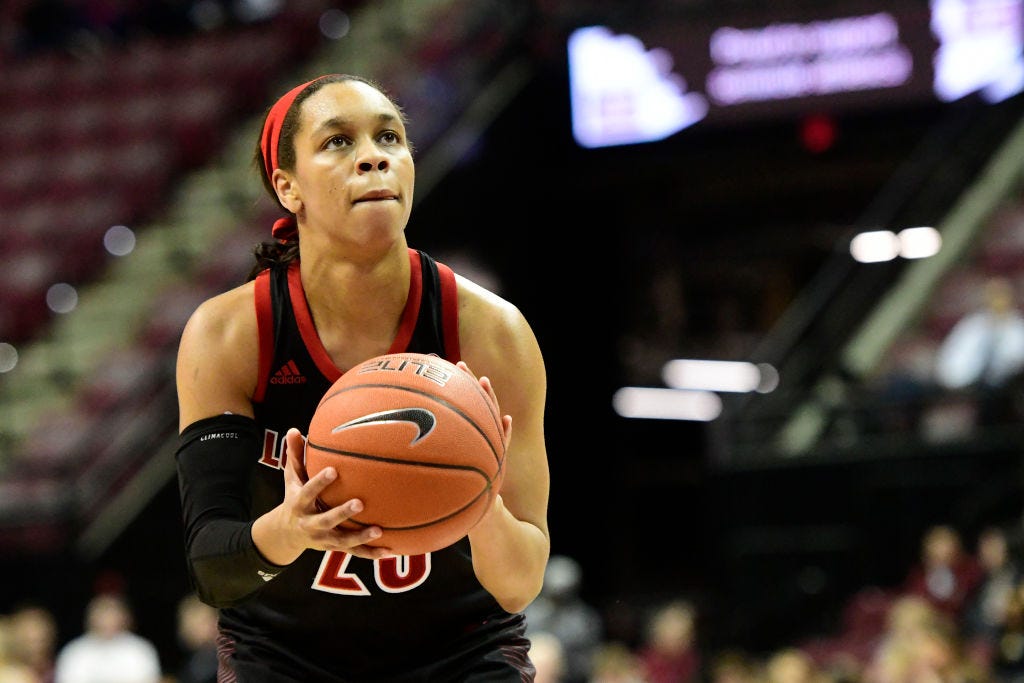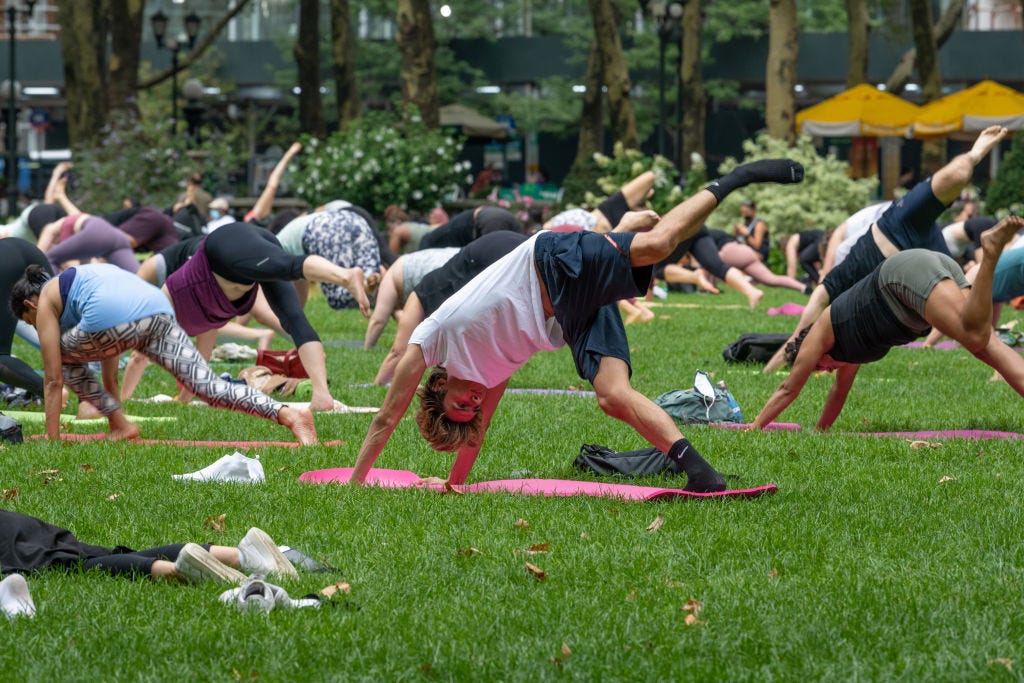Global Sport Matters: The Sport & the Body Issue (Part I)
Body-shaming in college track and field, athletes coping with long COVID, sports world make-believe that CTE is a new risk, and a study on what sports may help you live longer. Our Feb. issue is live!
Welcome to Hreal Sports, a newsletter written by Patrick Hruby about sports things that don’t stick to sports. Sign up and tell your friends!
As I mentioned last week, I’ve been expanding my editorial role at Global Sport Matters, the digital publication of the Global Sport Institute at Arizona State University. We cover a wide range of outside the lines, sports and society topics though original research and reporting, and via podcasts, live events, standalone articles, and monthly themed issues.
Speaking of which, our February issue is live. The theme is Sport and the Body—no, we haven’t produced a collection of tastefully-shot nude photographs of athletes and their otherworldly physiques, a la the dearly-departed ESPN The Magazine’s “The Body Issue”; yes, we are exploring the fundamental relationship between athletics, the human body, and the wide and changing range of issues associated with that.
If you’re thinking something along the lines of, '“hm, that’s a pretty vague editorial mandate,” then … you’re right. It is! It also gives us the freedom to publish an eclectic collection of pieces. The first four of those are summarized and linked below; they cover body-shaming in college track and field, athletes coping with long COVID, sports world make-believe that CTE is a new risk, and a study on what sports may help you live longer.
I hope you’ll check them out. I think you’ll be glad you did. Next week, we’ll be publishing our second batch of Sport and the Body stories, featuring pieces on “load management” in the National Basketball Association; older athletes who are pushing the limits of both their aging bodies and cultural expectations; unexpected and beneficial fat-positive spaces in sports; what the oft-at-odds cultures of sports and fitness can learn from each other; and something from yours truly on how and why women athletes on basically on their own when it comes to understanding how using the Pill may or may not affect their performances. Stay tuned!
“What We Can Learn From the Harmful Body-Shaming Culture Around the University of Oregon Track Program,” by Ashlyn Hare.
Last October, reporter Ken Goe of The Oregonian published a story in which six women athletes who left the University of Oregon’s track program said that the program’s emphasis on weight and body fat percentages created a dangerous culture of disordered eating.
Ashlyn Hare was one of those athletes. In this first-person piece, she shares what she saw and experienced at Oregon, how her attempts to raise concerns with school athletic administrators were unsuccessful, and how she thinks rules and culture within the storied track program need to change.
This emphasis on body fat percentage played out in many ways. In the fall, the coaches would assign extra cross-training if your percentage was considered too high. Usually, this consisted of an extra bike workout three times a week after practice. In my experience, cross-training applied only to women, despite the fact that there were men on the team who were known to have a body fat percentage that was also “too high.”
At the beginning of the year, our coaches would also give us composition notebooks to track our training and nutrition. We were supposed to track what we ate, when we ate it, the workout we did at practice, how we felt at practice, when we went to sleep, and when we woke up. On its face, that type of log is typical for any elite athlete, and it can be extremely beneficial. It’s good to know how your sleep and nutrition are impacting your training, and a log can help identify negative patterns that need to be changed, like failing to fuel after a workout or not getting enough sleep. But Oregon’s coaches would collect those diaries, review them, and give feedback. They would occasionally hand out diets, and athletes would be punished if they didn’t turn in their logs at practice.
People would do anything to trim their body fat percentage, resorting to diets that I’m sure our team nutritionists would not have endorsed had they known about them. Some would try to cut out carbohydrates. A few people relied on natural appetite suppressants. Nobody would eat dessert. No juice. No soda. Only water. There was always a conversation about whether or not you had earned yourself a waffle for breakfast after morning weights.
“From ‘Punch Drunk’ to CTE: How the Sports World Learned to Ignore Brain Trauma,” by Stephen T. Casper.
Ever since Bennet Omalu published a pathology report describing the neurodegenerative disease chronic traumatic encephalopathy (CTE) in the brain of deceased former National Football League player Mike Webster in 2005, journalists, sports organizations, Congress, and even Hollywood have grappled with what the risk of long-term brain damage means for American football.
Along the way, the general consensus has been that CTE is a new problem. But this perceived truth is a cultural myth. Stephen Casper—a historian of neurology and neuroscience who is researching and writing a book about the cultural history of brain injuries—uses the forgotten history of college boxing to show how CTE is an old problem, and how people in sports and medicine alike have known plenty about it for a very long time.
Last year, I came across a faculty report in the archives of the University of Illinois, Champaign-Urbana. Undated and plainly buried out of sight from the day it was written, it was obvious that it had been prepared in the late 1940s … the report investigated whether boxing should be encouraged at the collegiate level. Crucially, the report’s authors sent out surveys to neurologists and psychiatrists to ask them for their views. They asked other university authorities. They queried athletic directors for their opinions and sought guidance from directors of health services in other universities …
… death was not the primary problem. The report’s authors took the view that the more serious problem was the mental disturbances that “follow the accumulative effect of repeated blows to the head.” They remarked that such injuries also could occur in accidental falls, automobile accidents, and street fights, and that the illness was referred to scientifically as “traumatic encephalopathy or dementia pugilistica.” And they were troubled by the fact that that “remote symptoms develop insidiously or slowly,” allowing students to go through college “engaging in boxing without showing much evidence of changes in personality, mental patterns, concentration, etc., and in a few years after they have finished may definitely present these symptoms of mental degeneration.”
Writing that “the effects of head blows are cumulative and are not recognized in early stages,” they observed:
Some of the athletic directors believe that the term “punch drunk” is a newspaper coined phrase which does not actually exist. It is fortunate that they have not had any students with this disturbance. It is most unfortunate if such cases of dementia were developing, but in the early stages when they were not recognized, and those students allowed to continue boxing, added insult to injury.
“‘I’m Going Backward’: How Athletes Are Dealing With the Uncertainty of Long Covid,” by Alex Kirshner.
Long COVID-19 figures to be one of the most long-lasting repercussions of the coronavirus pandemic—and with bodies that are monitored so deeply, athletes have become conduits for understanding the disease and its effects.
Austin Phyfe never did figure out exactly how he got COVID-19. Nor did he feel like he needed to know. It was June 2021, and Phyfe was not only fully vaccinated but also a rising redshirt junior for the men’s basketball program at the University of Northern Iowa. A two-time all-conference forward, he was a picture of health in the prime of his athletic career. COVID didn’t bother him much, and his symptoms were limited to a day or two of lost taste and smell. He thought it might’ve been early-summer allergies, but he went for a COVID test because, he says, “you never know anymore.”
At the time of his diagnosis, Phyfe had a COVID story that was typical of most college athletes – and of healthy 20-somethings in general. In mid-June, after 10 days of isolation, he entered UNI’s return-to-play conditioning program for athletes who had tested positive. It was a program that by design had a gradual buildup of athletic activity. “You have to work your way back into it a little bit,” Phyfe says. “They don’t wanna kill you.”
For the first few days, Phyfe struggled to catch his breath and move at his usual pace, a difficulty he chalked up to “lingering aftereffects that might clear.” Better days followed, providing encouragement that he was turning a corner. Only his progress wasn’t linear. There were bad days as well – and too many of them. Six weeks after his return, Phyfe found himself coming to grips with a new normal, one that was far from his pre-COVID baseline.
“I was progressing a little bit, but then just kind of hit a standstill, where nothing was really progressing,” he says. “It was still tough every day just to have that consistency of being able to go up and down for whatever it may be: three, four, five minutes. There were some days when I was feeling better, and there were some days when I was feeling worse.”
“Could Fitness Exercises Be the Key To a Longer Life?” by Brendon Kleen.
Personal workouts are often thought of in terms of training for competition, weight loss, or social connection. But recent Global Sport Institute research indicates it could help people live longer lives, too.
Every New Year brings new fitness goals – but what if smarter workouts could also extend your life?
Recent Global Sport Institute research conducted by Connor Sheehan, PhD, and graduate assistant Longfeng Li sought to answer the question of whether affordable, accessible fitness workouts have an association with longer life. Using data from a National Health Interview Survey of nearly 27,000 Americans in 1998 and analyzed the association between 15 types of exercise and mortality through 2015 using estimated odds ratios and confidence intervals, Sheehan and Li found that:
Any exercise is better than none at all.
Adjusted for factors such as demographics and health status, “fitness exercises” consistently demonstrated better health outcomes than other workouts.
Walking, aerobics, stretching, weight lifting, and stair climbing were associated with a lower risk of death.
This has been Hreal Sports, a newsletter written by Patrick Hruby about sports things that don’t stick to sports. If you have any questions or feedback, contact me at my website, www.patrickhruby.net. And if you enjoyed this, please sign up and share with your friends.








